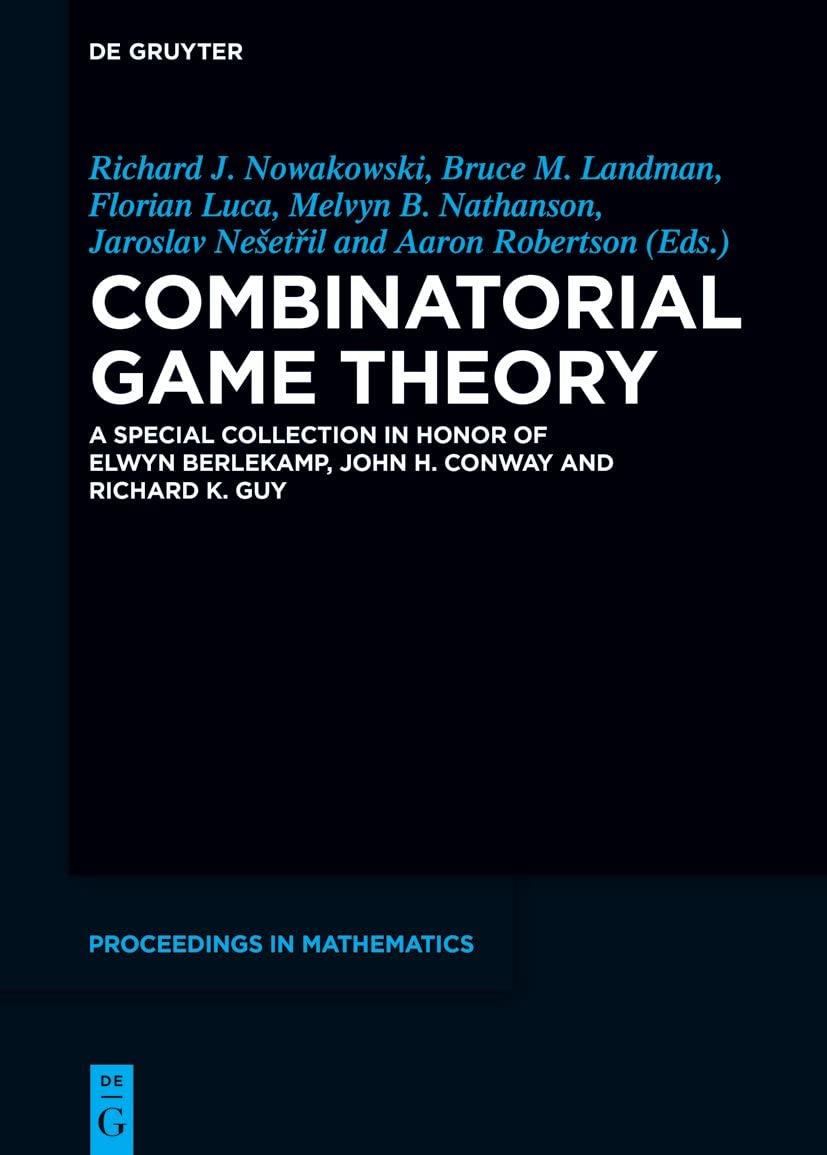Combinatorial Game Theory: A Special Collection in Honor of Elwyn Berlekamp, John H. Conway and Richard K. Guy
Richard J. Nowakowski
https://ebookmass.com/product/combinatorial-game-theory-a-specialcollection-in-honor-of-elwyn-berlekamp-john-h-conway-and-richard-kguy-richard-j-nowakowski/ ebookmass.com
Ecosocial Theory, Embodied Truths, and the People's Health Nancy Krieger
https://ebookmass.com/product/ecosocial-theory-embodied-truths-andthe-peoples-health-nancy-krieger/
ebookmass.com
Beckett and Modernism 1st ed. Edition Olga Beloborodova


https://ebookmass.com/product/beckett-and-modernism-1st-ed-editionolga-beloborodova/
ebookmass.com
Models of Quantum matter : a first course on integrability and the Bethe Ansatz First Edition. Edition Eckle
https://ebookmass.com/product/models-of-quantum-matter-a-first-courseon-integrability-and-the-bethe-ansatz-first-edition-edition-eckle/
ebookmass.com
Fundamentals on Oral and
Maxillofacial Surgery Divya


Mehrotra
https://ebookmass.com/product/fundamentals-on-oral-and-maxillofacialsurgery-divya-mehrotra/
ebookmass.com


Patrick M. Wright is the Thomas C. Vandiver Bicentennial Chair and the Director of the Center for Executive Succession in the Darla Moore School of Business at the University of South Carolina. Prior to joining USC, he served on the faculties at Cornell University, Texas A&M University, and the University of Notre Dame. Professor Wright teaches, conducts research, and consults in the area of strategic human resource management (SHRM), particularly focusing on how firms use people as a source of competitive advantage and the changing nature of the chief HR officer (CHRO) role. He is the faculty leader for the Cornell ILR Executive Education/NAHR program, “The Chief HR Officer: Strategies for Success,” aimed at developing potential successors to the CHRO role. He served as the lead editor on the recently released book, The Chief HR Officer: Defining the New Role of Human Resource Leaders, published by John Wiley and Sons. He has published more than 60 research articles in journals as well as more than 20 chapters in books and edited volumes. He is the Editor at the Journal of Management. He has coedited a special issue of Research in Personnel and Human Resources Management titled “Strategic Human Resource Management in the 21st Century” and guest edited a special issue of Human Resource Management Review titled “Research in Strategic HRM for the 21st Century.” He currently serves as a member on the Board of Directors for the National Academy of Human Resources (NAHR). He is a former board member of HRPS, SHRM Foundation, and World at Work (formerly American Compensation Association). From 2011 to 2015 he was named by HRM Magazine as one of the 20 “Most Influential Thought Leaders in HR.”
Preface
Managing human resources is a critical component of any company’s overall mission to provide value to customers, shareholders, employees, and the community in which it does business. Value includes profits as well as employee growth and satisfaction, creation of new jobs, contributions to community programs, protection of the environment, and innovative use of new technologies.
Our Approach: Engage, Focus, and Apply
Following graduation, most students will find themselves working in businesses or not-for-profit organizations. Regardless of position or career aspirations, their role in directly managing other employees or understanding human resource management (HRM) practices is critical for ensuring both company and personal success. Therefore, Fundamentals of Human Resource Management, Eighth Edition, focuses on human resource issues and how HR is a key component of any company’s overall corporate strategy. Fundamentals is applicable to both HR majors and students from other majors or colleges who are taking an HR course as an elective or a requirement.
Our approach to teaching human resource management involves engaging students in learning through the use of real-world examples and best practices; focusing them on important HR issues and concepts; and applying what they have learned through chapter features and end-of-chapter exercises and cases. Students not only learn about best practices but are actively engaged through the use of cases and decision making. As a result, students will be able to take what they have learned in the course and apply it to solving HRM problems they will encounter on the job.
Each chapter includes several different pedagogical features. “Best Practices” provides examples of companies whose HR activities work well.
Part 3 (Chapters 9–11) focuses on assessing and improving performance. Chapter 9 sets the tone for this section by discussing the important role of HRM in creating and maintaining an organization that achieves a high level of performance for employees, managers, customers, shareholders, and the community. Chapter 10 examines the strengths and weaknesses of different performance management systems. Chapter 11 discusses how to maximize employee engagement and productivity and retain valuable employees as well as how to fairly and humanely separate employees when the need arises.
Part 4 (Chapters 12–14) covers rewarding and compensating human resources, including how to design pay structures, recognize good performers, and provide benefits. Chapter 12 discusses how managers weigh the importance and costs of pay to develop a compensation structure and levels of pay for each job given the worth of the jobs, legal requirements, and employee judgments about the fairness of pay levels. Chapter 13 covers the advantages and disadvantages of different types of incentive pay, including merit pay, gainsharing, and stock ownership. Chapter 14 highlights the contents of employee benefits packages, the ways organizations administer benefits, and what companies can do to help employees understand the value of benefits and control benefits costs.
Part 5 (Chapters 15–16) covers other HR topics including collective bargaining and labor relations and managing human resources in a global organization. Chapter 15 explores HR activities as they pertain to employees who belong to unions or who are seeking to join unions. Concluding Part 5, Chapter 16 focuses on HR activities in international settings, including planning, selecting, training, and compensating employees who work overseas. The chapter also explores how cultural differences among countries and workers affect decisions about human resources.
page x human resources. Chapter 5 discusses how to develop an HR plan. It emphasizes the strengths and weaknesses of different options for dealing with shortages and excesses of human resources. Chapter 6 emphasizes that employee selection is a process that starts with screening applications and résumés and concludes with a job offer. Chapter 7 covers the features of effective training systems. Chapter 8 demonstrates how assessment, job experiences, formal courses, and mentoring relationships can be used to develop employees for future success.
today’s fast-paced business environment is forcing organizations to take a different approach to succession planning over a shorter timeline has been added.
Chapter 9 opens with a feature on how Amazon introduced employee surveys whose statistics are used by managers to help improve the work environment. In addition, a discussion has been added about the significance of critical thinking and knowledge sharing as more routine worker tasks become automated.
Chapter 10 provides an expanded discussion about how some organizations are rethinking their approach to performance reviews emphasizing ongoing performance feedback conversations between employees and their supervisors rather than an annual recap.
Chapter 11 includes a new table highlighting the HR practices that support effective separation and retention of employees. In addition, new real-world examples underscore the importance of employers recognizing that even their top employees may be looking for new jobs elsewhere and how to retain them.
Chapter 12 provides updated earning data for women, men, and minorities and suggests strategies companies can use to close the pay gaps. In addition, a new section highlights the legal requirement that companies must report the ratio of CEO pay to the pay of a typical worker in the organization.
Chapter 13 focuses on recognizing employee contributions with pay, including new examples of how businesses are rethinking their approach to bonuses and tying them to company performance.
Chapter 14 updates information on employee benefits as a percentage of total compensation, Social Security information, and taxes paid by both employers and employees.
Chapter 15 presents information on current trends and statistics in union membership and discusses the recent U.S. Supreme Court decision on whether unions infringe on individual rights when they require membership and/or dues.
Chapter 16 highlights trends in managing human resources globally, including the impact of recent tariffs imposed by the United States that will affect both domestic and foreign businesses, as well as the U.S.
California State Polytechnic University, Pomona
Huh-Jung Hahn
Winona State University
Michael B. Harari
Florida Atlantic University
Todd C. Harris
Bridgewater State University
Jeanne J. Holmes
North Carolina A&T State University
Uma Kedharnath
University of Wisconsin–Whitewater
Megan Kragness
University of Minnesota Crookston
page xiii
Bin Ma
Baruch College, City University of New York, University of Missouri, Columbia
Stephanie D. McKenzie
Houston Community College
Eivis Qenani
California Polytechnic State University, San Luis Obispo
Jim Russell
Purdue University
Joanna Shaw
Tarleton State University
David M. Sikora
Georgia Southern University
Paula Kirch Smith
Cincinnati State
Kris Sperstad
Chippewa Valley Technical College
Robert (Scott) Taylor
Moberly Area Community College
Gary Valcana
Athens State University
Yingchun Wang
University of Houston Downtown
Bruce A. Western
Western Illinois University
T. Craig Williams
East Carolina University
Nina E. Woodard
California State University, San Marcos
Weichu Xu
East Stroudsburg University
Raymond A. Noe
John R. Hollenbeck
Barry Gerhart
Patrick M. Wright

Students study more efficiently, retain more and achieve better outcomes. Instructors focus on what you love teaching.



